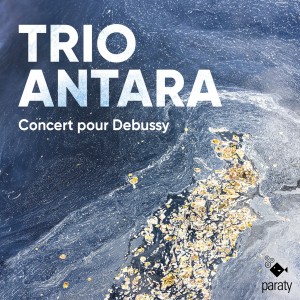
The discographic project Concert pour Debussy is the result of several years of collaboration between Trio Antara (Emmanuelle Ophèle – flute, Odile Auboin – viola, Ghislaine Petit-Volta – harp) and composer and artistic director Benoît Sitzia.
This recording crowns the long-standing work undertaken by the members of the Trio on Debussy’s Sonata for flute, viola, and harp (a project that began in Avignon on July 12, 2006, with composer and conductor Pierre Boulez), and more broadly on the deeper meaning of the cycle Six Sonatas for Various Instruments, of which the composer of Prélude à l’après-midi d’un faune began writing the first three between 1915 and 1917. Debussy’s death in 1918 left this cycle unfinished.
The Sonata for flute, viola, and harp – a true workshop-laboratory for Debussy’s thought and poetics – allowed for the rise and enduring legacy of this chamber ensemble formation, which has since inspired numerous new works. Its structure, its deliberate references to French musical tradition, and its questioning and re-examining of modernist and consequently contemporary ideologies, served as the foundation for the construction of this album’s program.
Thus, the idea of the baroque “concert” – with its nominal and imaginary tributes – responds to the poetic visions of Debussy, his contemporaries, and composers of our time.
An homage made of homages and images, exploring the ties of inspiration and meaning that transcend time and aesthetics. Like a revelation of a musical cosmogony, shedding light not so much on who Claude Debussy was, but on who he continues to be today.
The discographic project Concert pour Debussy is the result of several years of collaboration between Trio Antara (Emmanuelle Ophèle – flute, Odile Auboin – viola, Ghislaine Petit-Volta – harp) and composer and artistic director Benoît Sitzia.
This recording crowns the long-standing work undertaken by the members of the Trio on Debussy’s Sonata for flute, viola, and harp (a project that began in Avignon on July 12, 2006, with composer and conductor Pierre Boulez), and more broadly on the deeper meaning of the cycle Six Sonatas for Various Instruments, of which the composer of Prélude à l’après-midi d’un faune began writing the first three between 1915 and 1917. Debussy’s death in 1918 left this cycle unfinished.
The Sonata for flute, viola, and harp – a true workshop-laboratory for Debussy’s thought and poetics – allowed for the rise and enduring legacy of this chamber ensemble formation, which has since inspired numerous new works. Its structure, its deliberate references to French musical tradition, and its questioning and re-examining of modernist and consequently contemporary ideologies, served as the foundation for the construction of this album’s program.
Thus, the idea of the baroque “concert” – with its nominal and imaginary tributes – responds to the poetic visions of Debussy, his contemporaries, and composers of our time.
An homage made of homages and images, exploring the ties of inspiration and meaning that transcend time and aesthetics. Like a revelation of a musical cosmogony, shedding light not so much on who Claude Debussy was, but on who he continues to be today.

